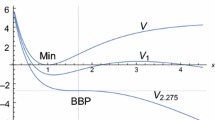Abstract
Most of the molecules react to form products by climbing a barrier. The energy involved in this climbing of the barrier is known as the activation energy of the reaction. Questions like how fast a reaction occurs can be answered by considering the height of the barrier. However, in some reactions, the reactants transform to products by directly tunnelling across the barrier instead of climbing over it. Such a purely quantum mechanical effect, which becomes more prominent for reactions at low temperatures can lead to interesting and even completely unexpected products. This effect and its consequences in representative examples are discussed.
Similar content being viewed by others
Suggested reading
P Atkins and R Friedman, Molecular Quantum Mechanics, 5th Edition, Oxford University Press, 2011.
M D Harmony, Quantum Mechanical Tunneling in Chemistry, Chem. Soc. Rev., Vol.1, pp.211–228, 1972.
T H Lowry and K S Richardson, Mechanism and Theory in Organic Chemistry, 3rd Edition, Addison Wesley Longman Inc. 1998. This book has a nice discussion on various types of KIE and their origin with examples and also mentions the role of QMT in KIE.
G Robert Shelton, David A Hrovat and Weston Thatcher Borden, J. Am. Chem. Soc., Vol.129, pp.164–168, 2007.
Benjamin A Ellingson and Donald G Truhlar, J. Am. Chem. Soc., Vol.129, pp.12765–12771, 2007.
Sarah M Remmert, Simon T Banks and David C Clary, J. Phys. Chem. A, Vol.113, pp.4255–4264, 2009.
Yi-Ping Liu, Gillian C Lynch, Thanh N Truong, Da-hong Lu, Donald G Truhlar and Bruce C Garrett, J. Am. Chem. Soc., Vol.115, pp.2408–2415, 1993.
Mijana Eckart-Maksic, Mario Vazdar, Mario Barbatti, Hans Lischka and Zvonimir B Maksic, J. Chem. Phys., Vol.125, p.064310-1–9, 2006.
Barry K Carpenter, J. Am. Chem. Soc., Vol.105, pp.1700–1701, 1983. This short communication discusses the probability of carbon tunnelling in CBD using a very similar model that we learnt for the inverted parabolic barrier.
Author information
Authors and Affiliations
Corresponding author
Additional information
Sharmistha Karmakar is doing her PhD in the group of Ayan Datta, IACS, Kolkata. Her research interests are modelling molecules with strong optical absorbtion and emission properties.
Deepthi Jose is doing her PhD in the group of Ayan Datta since 2009 in IISER, Trivandrum. Her research interests are in supramolecular chemistry and low-dimensional periodic systems like graphene and silicenes.
Ayan Datta is at IACS, Kolkata. His research interests span across various aspects of theoretical chemistry, structure and reactivity of clusters and molecular materials.
Rights and permissions
About this article
Cite this article
Karmakar, S., Jose, D. & Datta, A. Tunnelling effects in chemistry. Reson 19, 160–174 (2014). https://doi.org/10.1007/s12045-014-0019-9
Published:
Issue Date:
DOI: https://doi.org/10.1007/s12045-014-0019-9




